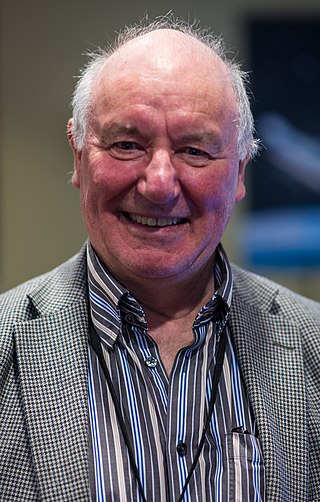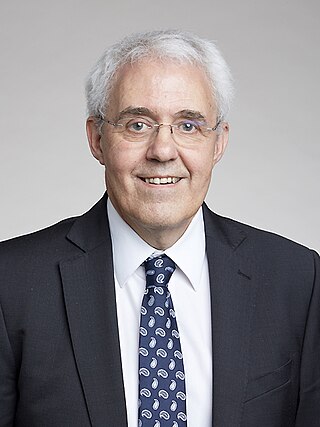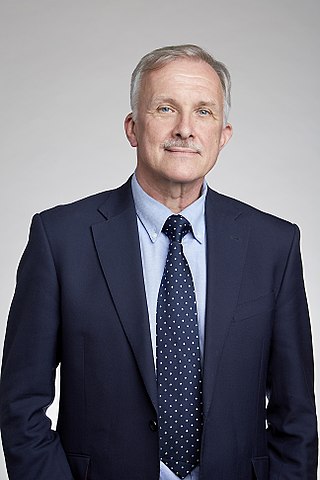Related Research Articles
Michael Boris Green is a British physicist and a pioneer of string theory. He is a Professor of Theoretical Physics in the School of Physics and Astronomy at Queen Mary University of London, emeritus professor in the Department of Applied Mathematics and Theoretical Physics and a Fellow of Clare Hall, Cambridge. He was Lucasian Professor of Mathematics from 2009 to 2015.

Malcolm Sim Longair is a British physicist. From 1991 to 2008 he was the Jacksonian Professor of Natural Philosophy in the Cavendish Laboratory at the University of Cambridge. Since 2016 he has been Editor-in-Chief of the Biographical Memoirs of Fellows of the Royal Society.
Samuel Tolansky, born Turlausky, FRAS FRSA FInstP FRS, was a British physicist. He was nominated for a Nobel Prize, has a crater on the Moon named after him near the Apollo 14 landing site and he was a principal investigator to the NASA lunar project known as the Apollo program.
Douglas Alan Ross is a British physicist. As of 2017 he is Professor Emeritus of physics at the University of Southampton.

Christopher Michael Bishop is a British computer scientist. He is a Microsoft Technical Fellow and Director of Microsoft Research AI4Science. He is also Honorary Professor of Computer Science at the University of Edinburgh, and a Fellow of Darwin College, Cambridge. Chris was a founding member of the UK AI Council, and in 2019 he was appointed to the Prime Minister’s Council for Science and Technology.
Nicholas John Higham FRS is a British numerical analyst. He is Royal Society Research Professor and Richardson Professor of Applied Mathematics in the Department of Mathematics at the University of Manchester.
Raymond Freeman FRS was a British chemist and professor at Jesus College, Cambridge who made important contributions to NMR spectroscopy.
Christopher Michael Hull is a professor of theoretical physics at Imperial College London. Hull is known for his work on string theory, M-theory, and generalized complex structures. Edward Witten drew partially from Hull's work for his development of M-theory.

Frederick Duncan Michael Haldane, known as F. Duncan Haldane, is a British-born physicist who is currently the Sherman Fairchild University Professor of Physics at Princeton University. He is a co-recipient of the 2016 Nobel Prize in Physics, along with David J. Thouless and J. Michael Kosterlitz.
Sir Charles Richard Arthur Catlow FLSW is a British chemist and professor at University College London and Cardiff University. Previously, he was Director of the Davy-Faraday Research Laboratory (1998–2007), and Wolfson Professor of Natural Philosophy at the Royal Institution. Since 2016, he has served as the foreign secretary of the Royal Society., and since 2021 as President of the InterAcademy Partnership (IAP).
Philip Candelas, is a British physicist and mathematician. After 20 years at the University of Texas at Austin, he served as Rouse Ball Professor of Mathematics at the University of Oxford until 2020 and is a Fellow of Wadham College, Oxford.

Julia Mary Yeomans is a British theoretical physicist active in the fields of soft condensed matter and biological physics. She has served as Professor of Physics at the University of Oxford since 2002.

Professor Rodney Loudon was a British physicist, best known for his work in quantum optics. He was Emeritus Professor of Theoretical Physics at the University of Essex.
Franz Daniel Kahn (1926–1998) was a mathematician and astrophysicist at the University of Manchester. He was Professor of Astronomy from 1966 to 1993, then Emeritus thereafter in the School of Physics and Astronomy.

Anthony Raymond Bell is a British physicist. He is a professor of physics at the University of Oxford and the Rutherford Appleton Laboratory. He is a senior research fellow at Somerville College, Oxford.

Neil Burgess is a British neuroscientist. He has been a professor of cognitive neuroscience at University College London since 2004 and a Wellcome Trust Principal Research Fellow since 2011. He has made important contributions to understanding memory and spatial cognition by developing computational models relating behaviour to activity in biological neural networks.

(James) Roy TaylorFREng is Professor of Ultrafast Physics and Technology at Imperial College London.

Guy Roderick Wilkinson is a particle physicist, working on the Large Hadron Collider project at CERN, professor of physics at the University of Oxford and a Fellow of Christ Church, where he holds the college's Alfred Moritz Studentship.

Timothy Peter Softley is Pro-vice-chancellor (PVC) for research and knowledge transfer at the University of Birmingham.
Richard Anthony Lewis JonesFInstP FLSW is professor of Materials Physics and Innovation Policy at the University of Manchester having been professor of physics at the University of Sheffield until 2020.
References
- ↑ Burgess, Neil (1990). Neural networks, human memory and optimisation. manchester.ac.uk (PhD thesis). University of Manchester.
- 1 2 3 "MOORE, Prof. Michael Arthur" . Who's Who . Vol. 2015 (online Oxford University Press ed.). A & C Black.(Subscription or UK public library membership required.)
- 1 2 3 4 5 6 7 Anon (1989). "Professor Michael Moore FRS". royalsociety.org. London: Royal Society. One or more of the preceding sentences incorporates text from the royalsociety.org website where:
“All text published under the heading 'Biography' on Fellow profile pages is available under Creative Commons Attribution 4.0 International License.” -- "Royal Society Terms, conditions and policies". Archived from the original on 11 November 2016. Retrieved 9 March 2016.
{{cite web}}: CS1 maint: bot: original URL status unknown (link) - ↑ Michael Moore publications indexed by the Scopus bibliographic database. (subscription required)
- 1 2 "Prof Michael Moore FRS". University of Manchester. Retrieved 23 August 2017.
- ↑ Moore, Michael Arthur (1967). Some problems in the theory of many-body systems. ethos.bl.uk (DPhil thesis). University of Oxford. Archived from the original on 12 December 2019. Retrieved 27 August 2017.
- ↑ Bray, Alan; Moore, Michael (1987). "Chaotic nature of the spin-glass phase". Physical Review Letters . 58 (1): 57–60. Bibcode:1987PhRvL..58...57B. doi:10.1103/PhysRevLett.58.57. ISSN 1079-7114. PMID 10034289.
